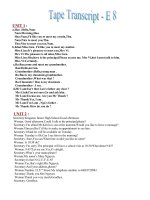- Trang chủ >>
- Đề thi >>
- THPT Quốc Gia
s2026 transcript
Bạn đang xem bản rút gọn của tài liệu. Xem và tải ngay bản đầy đủ của tài liệu tại đây (282.88 KB, 5 trang )
TRANSCRIPT
EPISODE 26: GENERAL TASK WRITING
Hello. I’m Margot Politis. Welcome to Study English, IELTS preparation.
Today we’re going to talk about letter writing.
IELTS Task 1 in the General Training module asks you to write a letter. We write
letters to friends, strangers, businesses, government departments and institutions.
The tone of a letter can be formal or informal, depending on who is going to read it.
There are several purposes for writing letters:
giving or requesting information;
giving instructions;
relating an event;
giving good or bad news;
complaining;
describing.
Some letters can include several of these purposes at the same time.
Here are some examples.
Letters for ‘giving information’ might
include: travel plans; arrival details;
what to see and do on holidays.
Letters ‘requesting information’ might
be for: course information; library
hours; timetable information.
Some letters for ‘giving instructions’
include: how to get to your house;
how to operate a machine; how to
open an account.
Page 1 of 5
And ‘relating an event’: an incident or
accident; a wedding or function or a
holiday.
‘Giving good or bad news’: cancelling
an appointment; accepting a job offer;
informing of the birth of a baby.
Letters ‘complaining’ might include:
poor service in a restaurant; loud
noise in your district; a problem with
faulty goods.
And letters ‘describing’ might be about: lost property; a friend; or a place.
OK. That’s an overview of different types of letter. Now let’s consider the
organisation of the letter.
Letters have a clear and familiar structure. Formal letters begin with a greeting ‘Dear
___”’, and end with ‘Yours sincerely’.
In between the top and the bottom, is ‘the body’. But what sort of body? How do we
decide about the shape of the letter between the greeting and the closing?
Well, we write because we have a purpose. It is important to indicate at the
beginning of a letter what its purpose is.
Let’s consider some examples.
If your letter is for giving information, you might start with: “I am writing to advise
that”;
or for requesting information: “I am writing to request information about”;
for giving instructions: “I am writing to explain how to”;
relating an event: “I am writing to describe the accident I saw”;
giving good or bad news: “I am very happy to tell you that”;
complaining: “I am writing to complain about”;
describing: “I am writing to describe some lost property”.
It’s easier for the reader of the letter if it’s organised coherently.
In Task 1, the way the IELTS General Training question is laid out will help you in
organising your response or answer.
Page 2 of 5
For example, look at the following question – a typical question for Task 1:
The way the question is constructed tells you how to organise your letter. There are
3 bullet points:
•
•
•
how long the course is,
how much the course costs, and
course pre-requisites’.
This tells you that you should construct 3 body paragraphs, one for each bullet point.
Thus your letter should look something like this.
First a greeting:
Dear Sir/Madam,
Then an introduction stating a
purpose:
I am writing because …
Then the body:
1. how long the course is
2. how much the course costs
3. course pre-requisites
And then finally, the closing:
Yours sincerely,
So when writing your IELTS letter, it’s a matter of being logical and organising your
ideas.
Page 3 of 5
Let’s look at another question and decide how to tackle it.
If we follow the same strategy as last time, our letter organisation will look something
like this.
First a greeting:
Dear Sir/Madam,
Then an introduction stating a
purpose:
I am writing because …
Then the body:
1. explain where you left your
briefcase
2. describe the briefcase
3. advise how to inform you, and where to send it, if found
And then finish with the closing:
Yours sincerely
The last thing to discuss about the letters you’ll be writing is the level of formality.
The two IELTS letters we looked at should be formal.
There will be times when you will have to compose a less formal letter, with different
language choices.
Page 4 of 5
Here are some examples:
more formal
less formal
“I am writing to enquire about the cost of
your IELTS Preparation Program.”
“I am writing to ask about the cost of your
IELTS Preparation Program.”
“This is due to the fact that teaching costs
have increased.”
“This is because teaching costs have
increased.”
If you require further information
If you need more information
“Please find enclosed”
“Here are”
“We have been forced to increase fees.”
“We’ve had to increase fees.”
“I regret to advise you.”
“I’m sorry to ‘tell’ you.
“I will not be able to attend.”
“I cannot come.”
Well, you should now be able to
practise letter writing. Remember,
each letter you write will have a
different purpose, and a clear purpose
statement will convey your intent to the
reader.
Organise the letter into several short
paragraphs, and choose the tone
carefully. Should it be more or less
formal?
To find more information and tips, don’t forget to visit our website. It’s
australianetwork.com/studyenglish. You’ll find all the stories, transcripts, study notes,
exercises and quizzes for the series.
That’s all for now. I hope to see you again for another episode of Study English. Bye
bye.
Page 5 of 5









